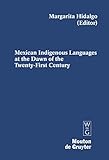Mexican Indigenous Languages at the Dawn of the Twenty-First Century / ed. by Margarita Hidalgo.
Material type: TextSeries: Contributions to the Sociology of Language [CSL] ; 91Publisher: Berlin ; Boston : De Gruyter Mouton, [2008]Copyright date: ©2006Description: 1 online resource (382 p.)Content type:
TextSeries: Contributions to the Sociology of Language [CSL] ; 91Publisher: Berlin ; Boston : De Gruyter Mouton, [2008]Copyright date: ©2006Description: 1 online resource (382 p.)Content type: - 9783110185973
- 9783110197679
- 497.0972 22
- PM3008
- online - DeGruyter
- Issued also in print.
| Item type | Current library | Call number | URL | Status | Notes | Barcode | |
|---|---|---|---|---|---|---|---|
 eBook
eBook
|
Biblioteca "Angelicum" Pont. Univ. S.Tommaso d'Aquino Nuvola online | online - DeGruyter (Browse shelf(Opens below)) | Online access | Not for loan (Accesso limitato) | Accesso per gli utenti autorizzati / Access for authorized users | (dgr)9783110197679 |
Frontmatter -- Contents -- Part I. History and theory -- Chapter 1 Mexican indigenous languagesin the -- twenty-first century -- Chapter 2 The Indianization of Spaniards in New -- Spain -- Chapter 3 The multiple dimensions of language -- maintenance and shift in colonial Mexico -- Chapter 4 Socio-historical determinants in the -- survival of Mexican indigenous languages -- Part II. Language policy -- Chapter 5 Legislating diversity in twenty-first -- century Mexico -- Chapter 6 Centralization vs. local initiatives. -- Mexican and U.S. legislation of Amerindian languages -- Chapter 7 The Mexican indigenous languages and the -- national censuses: 1970–2000 -- Part III. Bilingualism and bilingual -- education -- Chapter 8 Local language promoters and new -- discursive spaces: Mexicano in and out of schools in Tlaxcala -- Chapter 9 Bilingual education: Strategy for -- language maintenance or shift of Yucatec Maya? -- Chapter 10 Intervention in indigenous education. -- Culturally-sensitive materials for bilingual Nahuatl speakers -- Chapter 11 Stages of bilingualism. Local -- conversational practices among Mazahuas -- IV. Conclusions -- Chapter 12 Language policy. Past, present, and -- future -- Backmatter
restricted access online access with authorization star
http://purl.org/coar/access_right/c_16ec
This volume explores the reversing language shift (RLS) theory in the Mexican scenario from various viewpoints: The sociohistorical perspective delves into the dynamics of power that emerged in the Mexican colony as a result of the presence of Spanish. It examines the processes of external and internal Indianization affecting the early European protagonists and the varied dimensions of language shift and maintenance of the Mexican colonial period. The Mexican case sheds light upon language contact from the time in which Western civilization came into contact with the Mesoamerican peoples, for the encounter began with a demographic catastrophe that motivated a recovery mission. While the recovery of Mexican indigenous languages (MIL) was remarkable, RLS ended after fifty years of abundant productivity in MIL. Since then, the slow process of recovery is related to demographic changes, socioreligious movements, rebellion, confrontation, and survival strategies that have fostered language maintenance with bilingualism and language shift with culture preservation. The causes of the Chiapas uprising are analyzed in connection with the language attitudes of the indigenous peoples, while language policy is discussed in reference to the new Law of Linguistic Rights of the Indigenous Peoples (2003). A quantitative classification of the MIL is offered with an overview of their geographic distribution, trends of macrosocietal bilingualism, use in the home domain, and permanence in the original Mesoamerican settlements. Innovative models of bilingual education are presented along with relevant data on several communities and the philosophies and methodologies justifying the programs. A model of Mazahua language use is presented along the Graded Intergenerational Disruption Scale.
Issued also in print.
Mode of access: Internet via World Wide Web.
In English.
Description based on online resource; title from PDF title page (publisher's Web site, viewed 28. Feb 2023)


